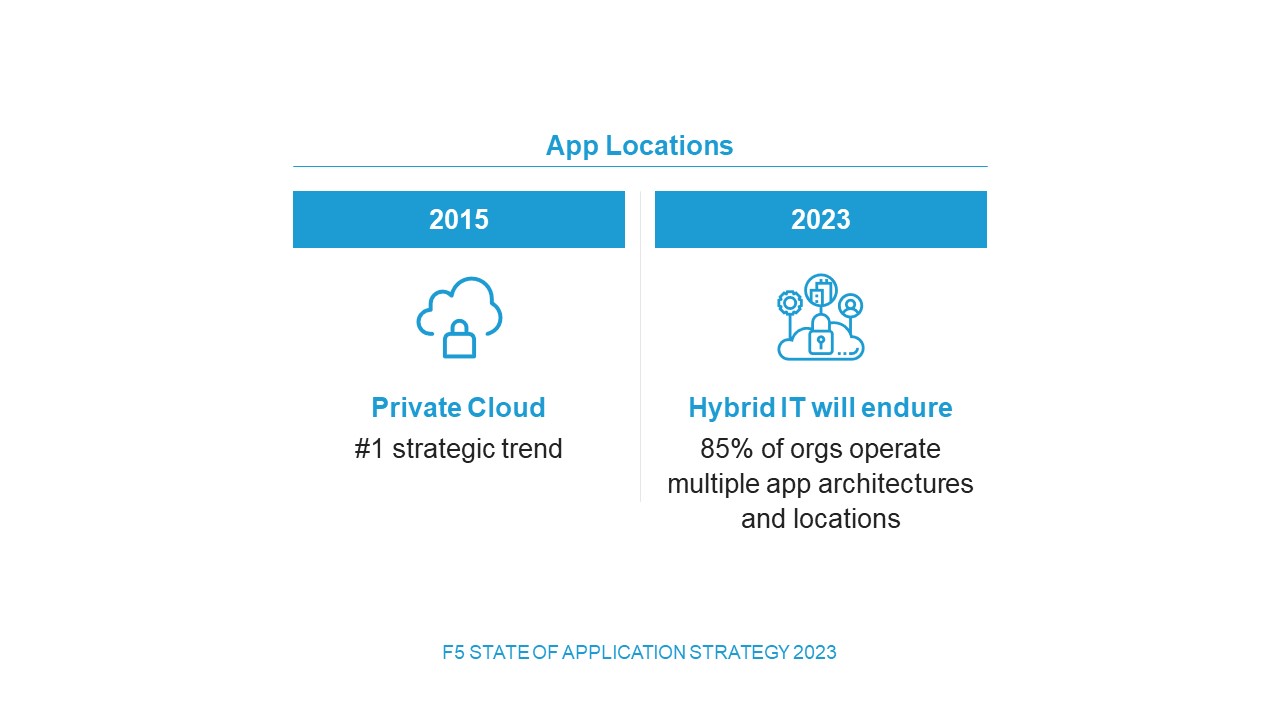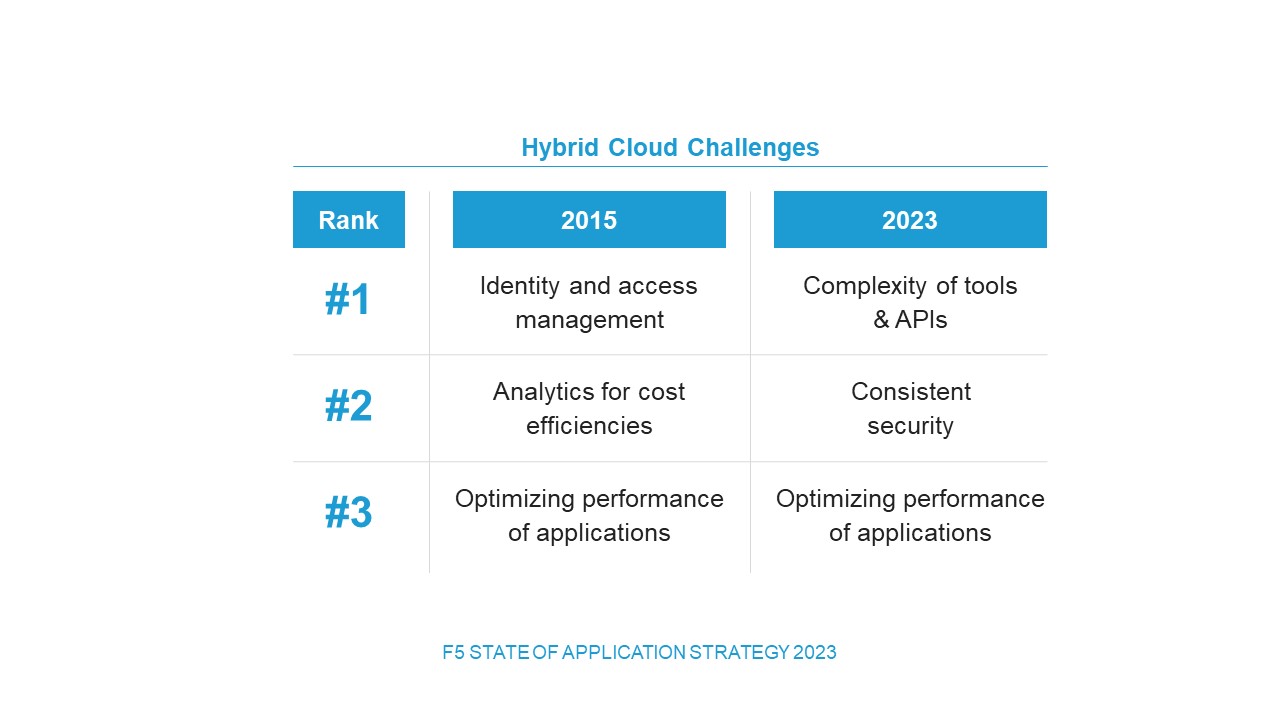Stand der Anwendungsstrategie: Ein Jahrzehnt voller Daten
Im Jahr 2014 begannen Lori MacVittie und ich darüber zu diskutieren, wie wichtig Anwendungsdienste für die Apps sind, die Initiativen zur digitalen Transformation vorantreiben. Wir gingen davon aus, dass der Erfolg dieser Geschäftsinitiativen letztlich von der Leistung, Bereitstellung und Sicherheit der Anwendungen abhängen würde. Die Verheißungen der digitalen Transformation begannen gerade, unsere Arbeits- und Freizeitgewohnheiten zu verändern: „Happy“ von Pharrell Williams war 2014 der Nr.-1-Song in den Billboard-Charts und „Die Eiskönigin“ von Disney mit allem Drum und Dran dominierte die Liste der Weihnachtsspielzeuge . Lassen Sie uns auf unsere ersten Erkenntnisse zurückblicken, um zu sehen, wo wir standen und welche Erkenntnisse wir auf dem Weg gewonnen haben.
In unserem ersten Bericht im Jahr 2015 war die Private Cloud der Trend Nummer eins. Die Investitionsvorteile der Servervirtualisierung waren real, da 80 % der x86-Workloads virtualisiert waren, die Unternehmen wollten jedoch die Agilität und Flexibilität erreichen, die ein wirklich softwaregesteuerter Ansatz über den gesamten IT-Stack hinweg mit sich bringt. Da die meisten Unternehmen zögern, ihre Datenhoheit an die öffentliche Cloud abzugeben, entscheiden sie sich dafür, ihre eigenen Rechenzentren in Ordnung zu bringen.
Seit den Debatten der Vergangenheit, ob öffentlich oder privat, haben wir einen weiten Weg zurückgelegt. In unserem Bericht für 2023 stellten wir fest, dass der durchschnittliche IT-Stack hybrid bleiben wird, wobei Funktionen wie Rechenleistung, Netzwerk, Speicher und Anwendungen weit über Kern-, Cloud- und Edge-Umgebungen verteilt sein werden. Nicht nur Clouds können als „hybrid“ betrachtet werden. Unternehmen werden weiterhin mehrere unterschiedliche Technologie-Stacks verwalten und verschiedene Generationen von Infrastrukturen und Apps unterstützen. Im Jahr 2024 erwarten wir, dass Hybrid-Modelle mit den Erfahrungen aus den Anfängen der Cloud-Anwendung auf KI bestehen bleiben. Unternehmen werden sich gut überlegen, wo sie ihre KI-Modelle/Workloads platzieren und verteilen, wobei sie der Datensouveränität Priorität einräumen UND branchenführende, öffentlich verfügbare große Sprachmodelle nutzen.
Hybride Herausforderungen
In unserem ersten Bericht setzten sich die Organisationen mit hybriden Herausforderungen auseinander, insbesondere mit der Frage, wie Identitäts- und Zugriffsverwaltung über Hybrid-Cloud-Bereitstellungen hinweg bereitgestellt werden kann. Die Ermittlung des besten Ansatzes für Single Sign-On dominierte die technische Agenda, wobei der erste Schritt die Bestandsaufnahme der Anwendungsstandorte und -architekturen war. Glücklicherweise hat die Branche darauf reagiert und Identitäts- und Zugriffsbarrieren abgebaut, sodass Identität und Zugriff heute die am weitesten verbreiteten App-Dienste sind. Traurigerweise sind neue Herausforderungen aufgetaucht und andere mussten bestehen bleiben.
Die unzähligen Tools und APIs, die von verschiedenen Technologie- und Cloud-Service-Anbietern mit jeweils leicht unterschiedlichen Merkmalen und Funktionen angeboten werden, stellen für die ohnehin unter Zeitdruck stehenden IT-Teams eine enorme Belastung dar und führen zu einem Mangel an Standardisierung und Integration. Eine einheitliche Sicherheit über hybride Standorte und App-Architekturen hinweg ist seit 2018 eine der größten Herausforderungen und ist es auch heute noch. Unternehmen möchten in ihrer hybriden Umgebung durchgängig Sicherheit implementieren, die den zahlreichen gesetzlichen Anforderungen entspricht, denen globale Unternehmen unterliegen. Diese beiden größten hybriden Herausforderungen untermauern, warum Multi-Cloud-Networking (MCN), das die Konnektivität zwischen mehreren Cloud-Standorten und -Architekturen abstrahiert, im Jahr 2023 ein Top-Trend war.
Und die Leistung von Anwendungen – nun ja, das war ein Top-Trend in unserem ersten Bericht und wird nicht so schnell verschwinden. Laut Google erhöht sich die Wahrscheinlichkeit, dass ein mobiler Site-Besucher abspringt, um 123 %, wenn sich die Seitenladezeit von 1 auf 10 Sekunden erhöht. Der Leistungsschwerpunkt liegt nicht nur auf öffentlich zugänglichen Apps. Unsere Untersuchungen zum Stand der Anwendungsstrategie haben ergeben, dass sich die Bemühungen zur digitalen Transformation wahrscheinlich ebenso auf interne Geschäftsfunktionen konzentrieren, bei denen die Produktivität und Zufriedenheit der Mitarbeiter wichtige Ergebnisse sind, die durch Hochleistungsanwendungen ermöglicht werden.
Vorhersagen für 2024? Überraschung, Überraschung: Generative KI wird ein Top-Trend sein und ich gehe davon aus, dass Unternehmen bei der Platzierung ihrer KI-Modelle sorgfältiger vorgehen werden. Dabei werden sie sowohl die Fähigkeiten und Kosten der Mitarbeiter realistisch einschätzen als auch die langfristigen strategischen Vorteile bewerten. Was Lieder angeht, würde ich auf jeden Fall auf eines von Taylor Swift wetten, und ihre Freundschaftsbänder werden ganz oben auf der Geschenkliste stehen. Ganz oben auf meiner Liste für Freundschaftsbänder steht Lori MacVittie und wir hoffen, dass Sie uns das Geschenk machen, an der gerade gestarteten SOAS-Umfrage für 2024 teilzunehmen, um eine Dosis Realität in die ganze Aufregung um KI zu bringen. Bleiben Sie bis zum Ende der Umfrage, um uns mitzuteilen, welche Trends Sie aus dem Jahr 2014 bereut haben, denn auch wir können aus der Rückschau auf unsere Fehlschläge eine Menge lernen. Ich dachte zum Beispiel, dass SDN für NetOps- und SecOps-Experten ein neues Zeitalter der Agilität durch Automatisierung einläuten würde. Ich bin noch immer zuversichtlich, bin jetzt aber viel realistischer, was das Tempo der betrieblichen Veränderungen angeht.


